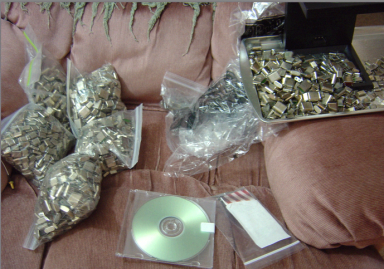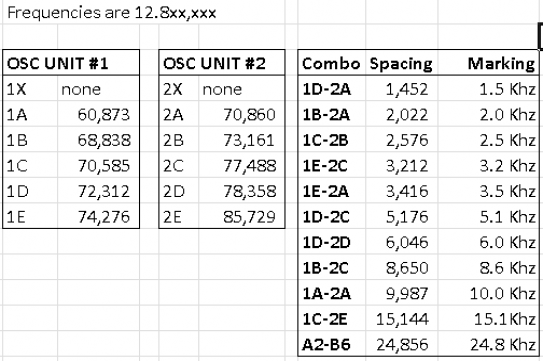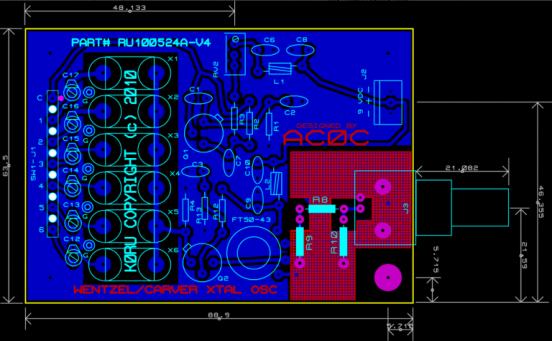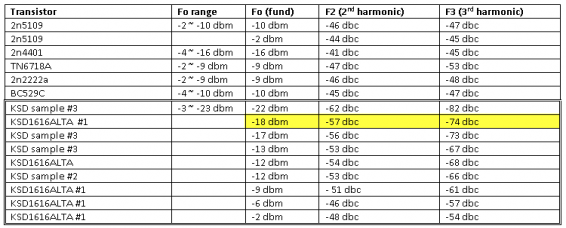Building a Cleaner 2-tone IMDDR3 Test SourceWith the external modifications, the unofficial estimates of IMD3 from the Dual Si570 based RF generator were about -90 to -95 dbc. I really worried that that was not enough. We were measuring 8x-9x db ranges on the FT-2000 filter project and that means the target signal purity coming from the test source really needed to be about -10dbc better than our best-case measurement. So the new threshold requirement was really something in the -110 dbc range. The only way to do that is with linear elements - either L/C or crystal. L/C is not stable enough without special circuitry and so building a crystal unit was the next step. After hunting around, it looked like the most documented oscillator design was the Wentzel which pulls the signal off the cold end of the crystal, essentially filtering the oscillator products through the crystal itself, and leading into a FET buffer to provide drive and further isolation. Here: http://www.wenzel.com/pdffiles1/pdfs/xtalosc.pdf Jeff Smith VE1ZAC used that same design to test his IC-7700 and rendered final results that matched the ARRL's high 90's DR3 number quite well. His story is found here: http://www3.ns.sympatico.ca/jhsmith/myweb4/Part%202%20IMDR.htm And Adam Farson VA7OJ documented his build using the same PCB layout with a slight mod to accomidate slightly different crystals. The 2nd/3rd harmonics were about -50dbc and the IMD products unmeasureable - and all that was without further filtering. I became convinced this design was the way to go. Bill Carver W7AAZ suggest replacing the FET buffer with a grounded base transistor to further increase linearity. I had resisted using a crystal solution because there is no initial provision to change frequency. However, while at Dayton, I ran across a vendor and purchased about 1000 crystals in the 12.xx Mhz range. That opened up the possiblity that, with some bench work, a combination of mix and match would provide for a wide spread of frequency spacing combinations.  That worked out exceptionally well. Crystals were graded by output and frequency level (without "pulling"). And then by selecting crystals of similar amplitude and with the proper needed frequency, the oscillator is able to run without further frequency manipulation. 
Using these hamfest special crystals has one down side. The individual characteristics with respect to stability and phase noise generation is unknown. But given the cost and long lead time to have special low-noise units built, this solution provides us with a tool sufficient to the task. And the best part is it's function right now so no further delays waiting for parts to come. 
The breadboard results were exceptional. Output of the oscillator circuit is about -5 dbm. The circuit has a 10db pad right at the output before the BNC jack to ensure proper termination and to increase return loss when used in the combiner circuit. With a final output of -15dbm, the F2 averages -58dbc and F3 is about -62dbc. When used with the combiner, the net output has IMD levels that are not detectable as would be expected. [see discussion toward end on transistor selection and harmonic levels] A Brick Wall for the HarmonicsIn actual use, I follow the individual oscillator outputs with a very serious LPF module providing severe attenuation of the 2nd and 3rd harmonics just for good measure. Internal construction is shown here. The mini-pcb is supplied courtesy of Jack Smith K8ZOA and provides nearly ideal termination for the filters. The insulated BNC jacks shown here were replaced with unsulated units to further improve isolation and ultimate rejection. The only real compromise on the design is the use of the machine pin sockets to allow easy frequency changes by swapping out the Coilcraft filters. 
VNA plots of the filter module look like this. For transmission attenuation, with fundamental, F2 and F3 marked. Suppression of -95dbc down on the 2nd and -81 dbc down on the 3rd harmonic: 
And leakage between signal sources is always a concern with respect to IMD generation. So looking at isolation here. 105db channel to channel isolation at the harmonics and 114 db at the fundamental: 
The combiner MC ZFAC-2-6+ measures right at 32db on our output frequency. So the overall system with oscillators, pads, LPF module and combiner looks like this: 
Adding up all these numbers, and we have some pretty nice looking numbers coming out of the combiner: - F2/F3 suppression of about -150dbc.
- Two way return loss of about 128db
Of course, there will be some leakage in there somewhere and these numbers won't be fully acheivable in reality. But I am very comfortable that the overall topology is sufficient to provide a clean enough test source for the FT-2000 project and the target goal of source IMD products below -100 dbc. I would welcome comments from knowledgable individuals with respect to the setup. Please contact me at the email address listed on the home page. PCB Version of the OscillatorsRob Underwood KØRU has taken the design and is building up some PCB for the final rendering. Differences in the PCB and the prototype versions are: - Use of the 2N5109 for the final output driver/buffer
- 6 turns on the trifillar transformer to allow lower frequency operation, if needed later
- A bit more emitter drive current (100 ohms vs. 82 in the final version)
- A lower final attenuator level (10 db in the prototype vs. 6 db in the final version) to allow for a heavier pad on the combiner's output.
The layout looks like this: 
And the final board looks like this. 
Great job, Rob. Mounted PCB. 
PCB PerformanceThe oscillator's output is really excellent. Completed assembly of the PCB unit brought these numbers in final testing: - Output level: -18 dbm
- 2nd harmonic: -57 dbc
- 3rd harmonic -74 dbc
With the added LPF following the oscillator modules, the fundamental signal purity is far, far in excess of what will be needed with the projects at hand. And probably for some time to come. How about those harmonic levels?One intersting note is the effect of the harmonic levels with transistor selection. Initially the prototypes were built iwth the KSD1616ALTA because that is what I had handy. It was not until the official target (2n2222a) was put in, and the harmonics about 10dbc worse than the prototypes, that I started to look more closely. Here's a spread of transistors, at various output levels (as determined by the oscilator voltage feed level set by the trimpot) vs. harmonic levels. Note the consistency of the 40-50dbc and essentially unchanged 3rd vs. 2nd harmonic levels. All, that is, except for the KSD1616ALTA. With all transistors, there is a relationship between the oscillator voltage level and harmonics. But only the KSD showed a lot better 3rd harmonic performance than the others. I have not looked into the circuit or the transistor parameters closely enough to have an opinion that explains this effect. I suspect this is a reflection not of the KSD quality and suitability, but rather of high capacitances and a limited hfe. But it is one of those rare but occasional strokes of good luck that we picked the KSD the first time. The prototypes performance was fantastic vs. our expectations, and regardless of the actual reason behind this specific transistor's performance, the numbers from the BNC jack look just great to this ham! 
|